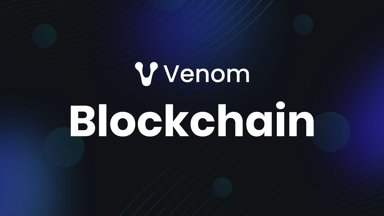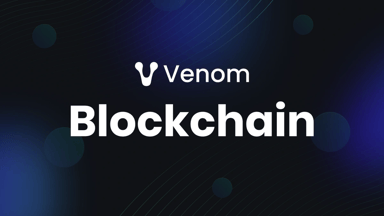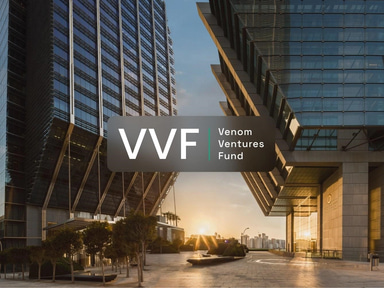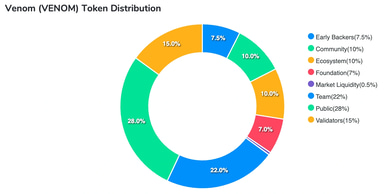읽기
편집
역사
알림
공유
Venom Foundation
The Venom Foundation is an organization building a blockchain platform that focuses on providing scalable, secure, and efficient solutions for decentralized applications (dApps) and digital assets. By addressing the limitations of existing blockchain technologies, Venom aims to support a wide range of industries, including finance, supply chain, and healthcare, through the application of blockchain technology.[3][4]
Overview
Venom Foundation is a blockchain-focused entity operating within the Abu Dhabi Global Market (ADGM), an international financial center in the UAE. As the first crypto foundation to receive a license in ADGM, Venom plays a pivotal role in the development of blockchain infrastructure across the Middle East and North Africa (MENA) region.
The foundation’s focus extends to supporting the adoption of Web3 technologies by governments and enterprises. Venom provides blockchain-based solutions that can be utilized for secure transactions, NFT platforms, and fiat-backed stablecoins, all in accordance with ADGM's regulatory framework. Through this approach, Venom aims to support the broader implementation of blockchain technologies in a compliant and accessible manner. [9][10]
Venom Blockchain
Venom is built on a unique consensus mechanism designed to enhance security and scalability, enabling it to handle a high volume of transactions per second (TPS). The platform also emphasizes interoperability, allowing seamless integration with other blockchain networks and traditional systems. This adaptability makes it suitable for both enterprise-level applications and smaller decentralized projects. Venom also supports smart contract functionality, enabling developers to build decentralized applications that leverage blockchain’s inherent security and transparency.
The ecosystem includes tools such as Venom Wallet, Venom Scan, and Venom Pools, facilitating the creation and management of decentralized applications (DApps) and supporting various blockchain functions, including staking and transaction verification.[1][4][11]
History
The concept of the Venom blockchain originated in 2018, initiated by Christopher Louis Tsu and Dr. Kai-Uwe Steck. The duo collaborated with an investment group from the United Arab Emirates, intending to build a blockchain capable of scaling to handle large workloads. Following years of development, the Venom network debuted with a closed testnet in April 2022 and opened to the public in April 2023. In March 2024, Venom’s mainnet went live, marking a significant milestone with its listing on major exchanges. The project’s core strength lies in its scalability, low transaction fees, and rapid processing capabilities.
Venom now operates as both a Layer 0 and Layer 1 blockchain, enabling developers to build scalable Web3 applications and engage in global payments. Venom’s architecture leverages dynamic sharding and Mesh technology to deliver an adaptable multi-blockchain system that caters to diverse use cases, including decentralized finance and enterprise applications. [5][6][7][8]
Technology
The Venom platform utilizes several technological innovations designed to improve scalability and security. Among them:
- Threaded Virtual Machine (TVM): TVM allows for efficient account interactions by using the Actor model, which isolates and parallelizes processes. This structure supports dynamic sharding, improving the scalability of the platform.
- Consensus Mechanism: Venom’s consensus mechanism helps mitigate risks such as double-spending and 51% attacks, ensuring the integrity of transactions.
- Account Abstraction: This feature allows developers to define account behavior through smart contracts, giving greater flexibility and modularity in dApp design.
- External Messaging: Venom facilitates communication between off-chain and on-chain systems, allowing external data to trigger actions within the blockchain network.
- Workchains: The platform supports the creation of specialized Layer 1 blockchains, or workchains, which can be customized to meet various security, privacy, and compliance needs.
- T-Sol: A developer-friendly language derived from Solidity, T-Sol simplifies onboarding for developers with experience in other programming languages like C, C++, and JavaScript.[3][4]
Key Features
- High Throughput: Venom is capable of processing over 100,000 transactions per second, making it ideal for large-scale applications.
- Low Transaction Fees: Transaction costs on Venom are kept minimal, with fees typically under $0.0002.
- Interoperability: The platform is designed to work seamlessly with other blockchain networks and legacy systems, promoting data exchange and collaboration.
- Zero Emission Policy: Venom’s operations are guided by a zero-emission approach to minimize environmental impact.[1][4]
Use Cases
The Venom platform has applications across multiple industries, including:
- Decentralized Finance (DeFi): Providing secure and efficient financial services through smart contracts.
- Supply Chain Management: Enhancing transparency and traceability, ensuring the authenticity of products throughout the supply chain.
- Healthcare: Securely storing and sharing medical records to improve patient care while protecting data privacy.[3][4]
Venom Ecosystem
Venom has developed a growing ecosystem of decentralized applications (dApps), tools, and services:
- Venom Wallet: A non-custodial wallet that allows users to securely manage their assets, available as both a browser extension and a mobile app.
- Venom Scan: A blockchain explorer that enables users to search and verify transactions, blocks, and other data on the Venom network.
- Grants and Staking: Venom offers grant programs to developers building on its platform, as well as staking solutions for users to earn rewards by locking their tokens.[3][4]
Governance and DAO Integration
Venom incorporates Decentralized Autonomous Organizations (DAOs) within its governance model. Through DAOs, token holders can participate in the decision-making processes that affect the network, allowing for decentralized governance without reliance on a central authority. DAOs within the Venom ecosystem can be used for various purposes, such as managing community projects and overseeing decentralized investment funds.[3][4]
Venom Token (VENOM)
The VENOM token serves as the native cryptocurrency of the Venom blockchain, a highly scalable platform designed to support decentralized applications (dApps), decentralized finance (DeFi) services, and other Web3 initiatives. As a TIP-3 standard token, VENOM integrates seamlessly into Venom’s distributed system, offering cost-efficient solutions for its fee model. The token plays a central role in the Venom ecosystem, supporting various functions such as paying transaction fees, staking, and participating in decentralized finance applications.[2][3][4][5]
As a core component of the Venom Network, VENOM enables users to engage with the platform's decentralized applications and serves as the primary unit of value within the ecosystem. This includes participation in staking, liquidity pools, and other Web3 activities.
Tokenomics
With an initial supply of 7.2 billion tokens, VENOM supports network activities by covering transaction fees, staking, and participation in governance. The VENOM token can be divided into smaller units: NanoVENOM, MicroVENOM, and MilliVENOM, enhancing its utility across different transactions. [12][13][14][15]
Initial Supply and Allocation
Upon mainnet launch, only 15.6% (1.116 billion) of the total supply will be unlocked, with the remaining 84.4% (6.084 billion) locked. This locked portion includes tokens reserved for validators, with 10% (720 million) designated as the initial validator stake.
The projected annual inflation rate for the VENOM token is set at -1%, equating to approximately -72 million VENOM tokens.
The distribution of VENOM tokens is structured to ensure balanced support across different segments of the ecosystem:
- Venom Ecosystem: 28%
- Venom Community: 22%
- Venom Foundation: 15%
- Market Liquidity: 10%
- Validators: 10%
- Early Backers: 7.5%
- Venom Team: 7%
- Public: 0.5%
Future Supply Model: Inflationary to Deflationary
Venom token currently follows an inflationary supply model with no hard cap on the total supply. However, the Venom Foundation is exploring a potential shift toward a deflationary model. One option under consideration is "fee burning," where a portion of transaction fees would be permanently removed from circulation by being sent to an inaccessible address. This transition aims to balance supply and demand within the ecosystem while preserving network stability and sustainability.
Use Cases for VENOM
VENOM operates as a versatile utility token within the Venom ecosystem. Its primary functions include:
- Transaction Fees: VENOM is used to pay for transaction fees within the Venom network, ensuring the smooth operation of decentralized applications.
- Staking and Governance: Token holders can participate in staking through DePools, securing the network and earning rewards. Additionally, VENOM enables participation in governance processes via Decentralized Autonomous Organizations (DAOs), influencing the direction of the network.
- DeFi and Asset Trading: The token plays a crucial role in Venom’s decentralized finance ecosystem, enabling users to engage in staking, liquidity provision, asset swaps, and yield farming activities on decentralized exchanges (DEXs).
- Gaming and NFTs: Users can participate in blockchain-based gaming, trade non-fungible tokens (NFTs), and interact with other decentralized applications using VENOM.
Token Standards
Venom’s token infrastructure is built on two core standards:
- TIP-3 (Fungible Token Standard): This standard governs the issuance and management of fungible tokens like VENOM. Similar to Ethereum’s ERC-20, TIP-3 allows users to transfer tokens, query balances, mint and burn tokens, and track supply.
- TIP-4 (Non-Fungible Token Standard): This standard facilitates the creation and exchange of NFTs, allowing users to mint, trade, and manage unique assets on the Venom blockchain.[2][3][4][5]
WVenom (Wrapped Venom)
Wrapped Venom (WVENOM) is a TIP-3 standard token designed to facilitate compatibility within decentralized finance (DeFi) protocols. While VENOM operates as the native currency of the Venom blockchain, many DeFi applications require a wrapped version of the token for ease of use and interoperability with smart contracts.
WVENOM serves as a 1:1 representation of VENOM, allowing users to wrap their native tokens for use within DeFi platforms. This process occurs automatically when interacting with decentralized exchanges (DEXs) or other DeFi protocols. For instance, when swapping VENOM for other assets like USDT, the token is first converted into WVENOM, which is then exchanged for the desired asset.
Although users may not need to interact directly with WVENOM, it plays an essential role in ensuring that Venom’s DeFi ecosystem remains compatible with smart contracts and other decentralized protocols.[2][3][4][5]
Venom Foundation
커밋 정보
편집자
편집 날짜
November 10, 2024
피드백
평균 평점
경험은 어땠나요?
빠른 평가를 해서 우리에게 알려주세요!
트위터 타임라인
로딩 중
미디어









참고 문헌.
[1]
[2]
Venom price today, VENOM to USD live price, marketcap and chart | CoinMarketCap
Aug 13, 2024
[3]
[4]
[5]
[6]
[7]
[8]
https://www.blockleaders.io/newsroom/venom-foundation-announces-the-release-of-its-public-testnet
Oct 17, 2024
[9]
Venom Foundation First Crypto Foundation Licensed in UAE’s ADGM to Build an Infinitely Scalable Blockchain
Oct 17, 2024
[10]
[11]
[12]
[13]
[14]
[15]
